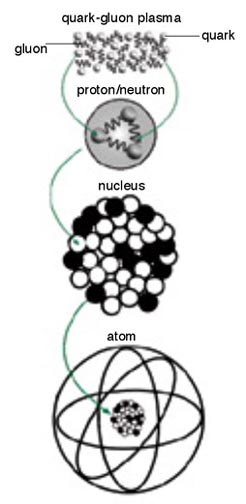Are you a journalist? Please sign up here for our press releases
Subscribe to our monthly newsletter:
 Graduate student Alexandre Kozlov%2C Prof. Zeev Fraenkel%2C Prof. Itzhak Tserruya%2C Dr. Ilia Ravinovich%2C and graduate student Alexander Cherlin. An international experiment.jpg)
In the first millionth of a second after the Big Bang, atoms as we know them today did not yet exist.
The jets of blazing matter that dispersed in all directions in those first few fractions of a second contained a mixture of infinitesimal particles (quarks and gluons), called the quark-gluon plasma. This was the first form of matter in the universe. Later on, when the universe cooled down a bit and became less dense, the quarks and gluons organized into various combinations, forming particles such as protons and neutrons. Since then, in fact, quarks and gluons have not existed as free particles in the universe.
Scientists have been trying to recreate the quark-gluon plasma in the lab in a joint experiment including 460 physicists from 57 research institutions in 12 countries. Recent results strongly indicate that they they are on the right track.
The ongoing project, called PHENIX, is being conducted at the Brookhaven National Laboratory in Long Island, using an accelerator, called RHIC (Relativistic Heavy Ion Collider), built especially for creating the quark-gluon plasma. The Israeli team is led by Prof. Itzhak Tserruya, head of the Weizmann Institute's Particle Physics Department. Tserruya and his colleagues designed and built special particle detectors, called pad chambers, which are a central part of PHENIX's detecting system.
The accelerator creates two beams of gold ions and accelerates them toward each other, causing a head-on collision. The power of the collision (about 40 trillion electron volts, the highest level of energy attainable in the lab) turns part of the beams' kinetic energy into heat, while the other part turns into various particles. The first stage in the creation of these new particles, like the first stage in the creation of matter in the Big Bang, is assumed to consist of the quark-gluon plasma.

Prof. Tserruya's research was supported by the Nella and Leon Benoziyo Center for High Energy Physics. He is the incumbent of the Samuel Sebba Professorial Chair of Pure and Applied Physics.
One of the ways to identify the quark-gluon plasma is by observing its interaction with other particles. When a single quark moves through regular matter, it emits radiation that slows down its progress somewhat. When it enters a very dense medium like quark-gluon plasma, its progress is slowed much more. That's precisely the phenomenon that has recently been observed and analyzed in the PHENIX project. According to physicists taking part in the experiment, these findings are very encouraging and could indicate that they have succeeded in creating the quark-gluon plasma.
Other than Tserruya, the Weizmann team participating in the PHENIX experiment included Prof. Zeev Fraenkel, Dr. Ilia Ravinovich, postdoctoral fellow Dr. Wei Xie and graduate students Alexandre Kozlov, Alexander Milov and Alexander Cherlin.